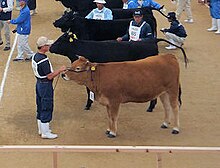 Japanese Brown (foreground) at a wagyū show in Sasebo, Nagasaki Japanese Brown (foreground) at a wagyū show in Sasebo, Nagasaki | |
| Conservation status | FAO (2007): not at risk |
|---|---|
| Other names |
|
| Country of origin | Japan |
| Distribution | |
| Use | meat |
| Traits | |
| Coat | brown |
| Horn status | horned in both sexes |
| |
The Japanese Brown (Japanese: 褐毛和種, Akage Washu or 赤牛, Aka Ushi) is a breed of small Japanese beef cattle. It is one of six native Japanese cattle breeds, and one of the four Japanese breeds known as wagyū, the others being the Japanese Black, the Japanese Polled and the Japanese Shorthorn. All wagyū cattle derive from cross-breeding in the early twentieth century of native Japanese cattle with imported stock, mostly from Europe. In the case of the Japanese Brown, the principal foreign influence was from the Korean Hanwoo and Swiss Simmental breeds.
Etymology
The Kanji characters 赤牛 literally mean "red cow".
History
Cattle were brought to Japan from China at the same time as the cultivation of rice, in about the second century AD, in the Yayoi period. Until about the time of the Meiji Restoration in 1868, they were used only as draught animals, in agriculture, forestry, mining and for transport, and as a source of fertiliser. Milk consumption was unknown, and – for cultural and religious reasons – meat was not eaten. Cattle were highly prized and valuable, too expensive for a poor farmer to buy.
Japan was effectively isolated from the rest of the world from 1635 until 1854; there was no possibility of intromission of foreign genes to the cattle population during this time. Between 1868, the year of the Meiji Restoration, and 1887, some 2600 foreign cattle were imported. At first there was little interest in cross-breeding these with native stock, but from about 1900 it became widespread. It ceased abruptly in 1910, when it was realised that, while the cross-breeds might be larger and have better dairy qualities, their working capacity and meat quality was lower. From 1919, the various heterogeneous regional populations that resulted from this brief period of cross-breeding were registered and selected as "Improved Japanese Cattle". Four separate strains were characterised, based mainly on which type of foreign cattle had most influenced the hybrids, and were recognised as breeds in 1944. These were the four wagyū breeds, the Japanese Brown, the Japanese Black, the Japanese Polled and the Japanese Shorthorn.
The Japanese Brown developed in southern Japan, in Kōchi Prefecture on Shikoku island, and in Kumamoto Prefecture on Kyushu island. The principal foreign influences on the breed were from the British Devon, Korean Hanwoo and Swiss Simmental cattle breeds.
In 1960 the total breed population was reported to be over 525000. In 1978 it was reported as 72000, and in 2008 it was 18672. The Japanese Brown constitutes about 4.8% of the national beef herd. Its conservation status was listed by the FAO in 2007 as "not at risk".
A small number were exported to the United States in 1994.
Characteristics
Japanese Brown cattle in Kōchi Prefecture are reddish-brown, while those in Kumamoto Prefecture are light brown; both sexes are horned.
References
- ^ Breed data sheet: Japanese Brown/Japan. Domestic Animal Diversity Information System of the Food and Agriculture Organization of the United Nations. Accessed January 2017.
- Breeds reported by Japan: Cattle. Domestic Animal Diversity Information System of the Food and Agriculture Organization of the United Nations. Accessed January 2017.
- T. Muramoto, M. Higashiyama, T. Kondo (2005). Effect of pasture finishing on beef quality of Japanese Brown steers. Asian-Australian Journal of Animal Science. 18: 420-426.
- ^ Kiyoshi Namikawa (2016 ). Breeding history of Japanese beef cattle and preservation of genetic resources as economic farm animals. Kyoto: Wagyu Registry Association. Accessed January 2017.
- Valerie Porter, Lawrence Alderson, Stephen J.G. Hall, D. Phillip Sponenberg (2016). Mason's World Encyclopedia of Livestock Breeds and Breeding (sixth edition). Wallingford: CABI. ISBN 9781780647944.
- (2005). Country Report: Japan, annex to The State of the World's Animal Genetic Resources for Food and Agriculture. Rome: Food and Agriculture Organization of the United Nations. ISBN 9789251057629. Accessed January 2017.
- Barbara Rischkowsky, D. Pilling (eds.) (2007). List of breeds documented in the Global Databank for Animal Genetic Resources, annex to The State of the World's Animal Genetic Resources for Food and Agriculture. Rome: Food and Agriculture Organization of the United Nations. ISBN 9789251057629. Accessed January 2017.
- Michelle Roberts (16 July 2007). Japanese cow herd protected, coddled for 12 years to make Kobe beef. Deseret News. Archived 7 January 2017.
| Cattle breeds of Japan | |
|---|---|
| These are the cattle breeds considered in Japan to be wholly or partly of Japanese origin. Inclusion here does not necessarily imply that a breed is predominantly or exclusively Japanese. | |
| See also: Wagyu • Cattle in Japan |